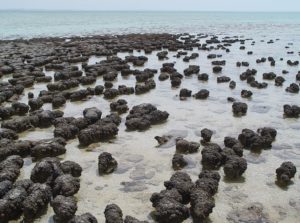Click the following for an Origin of Life Student Learning Guide Handout
1. Introduction
There are only a few questions that are as deep as how did life emerge? The origin of life is the basis of your existence (and mine). It’s about our existence, a species that can contemplate its own existence, and perhaps, one day, spread awareness to other planets, and even to other stars.
If you’re like me, you probably have many questions about the origin of life. I hope that we’ll answer some of them in this series of tutorials. At the same time, I want to acknowledge that unlike the other modules on this website, this is not one where you’ll find definitive answers. The science around the origin of life is, by nature, speculative. What I’ll try to do is sketch a reasonable and plausible account of what might have happened, knowing that other pathways to the first living cells may have been possible. Let’s start.
2. Life and LUCA (the Last Universal Common Ancestor)
We’ll start with an interactive reading that will outline some of the major issues connected to the origin of life.
[qwiz qrecord_id=”sciencemusicvideosMeister1961-Life and Luca, IR”]
[h]Interactive reading: Life and LUCA
[i]An origin of life haiku
Life emerged just once
But where on Earth, and why here
And, above all, how
[q labels = “top”]One of the foundations of biology is the cell theory. It consists of three ideas
- All living organisms are composed of one or more ________.
- The cell is the basic unit of ______________, function, and organization in living organisms.
- All cells arise from ____________ cells.
[l]structure
[fx] No. Please try again.
[f*] Excellent!
[l]pre-existing
[fx] No, that’s not correct. Please try again.
[f*] Good!
[l]cells
[fx] No. Please try again.
[f*] Excellent!
[q labels = “top”]
But the cell theory leaves us with a mystery. If all cells come from ___________ cells, then how did the ______ ______ arise?
[l]cells
[fx] No. Please try again.
[f*] Correct!
[l]first
[fx] No, that’s not correct. Please try again.
[f*] Great!
[l]pre-existing
[fx] No, that’s not correct. Please try again.
[f*] Excellent!
[q]Explaining the origin of the first living cells is the purpose of this module. Before we dive in, please use your student learning guide (there’s a link to one at the top of this page) to answer the questions below. Formulating your own answers will help prepare your mind for the learning to come. Be sure to ground your speculations in the biology you’ve been learning.
- What was the first living thing like? Think of broad categories like prokaryotic, eukaryotic, single-celled, multicellular, aerobic, anaerobic, etc. Using the biology you know, describe the first living thing as specifically as possible.
- When did life first arise?
- All living things share properties like DNA, RNA, and protein synthesis via ribosomes, membranes, etc. Even on a molecular level, life is complex. How could living cells, with all of their complexity, have arisen from non-living matter?
- Based on the shared characteristics of all living things (DNA, RNA, protein, ribosomes, chemiosmosis, a shared genetic code, etc.), it’s clear that life arose only once. That means that it arose in one place, and spread from there, the first of life’s great adaptive radiations. What’s the most likely place for life to have arisen? Note that I’m not asking for a specific location (such as “North Berkeley, on the corner of Vine and Shattuck”), but for a type of environment.
When you’re done writing out your answers, click “continue.”
[q labels = “top”]
We’ll come back to each of these questions later. For now, let’s try to hone in on what we’re trying to explain. What, exactly, is life? Here’s how NASA (the U.S. National Aeronautics and Space Administration) defines life:
“A self-__________ chemical __________ capable of __________evolution.”
[l]Darwinian
[fx] No. Please try again.
[f*] Good!
[l]sustaining
[fx] No. Please try again.
[f*] Good!
[l]system
[fx] No. Please try again.
[f*] Great!
[q labels = “top”]Let’s take NASA’s definition apart. Here it is again.
A self-sustaining chemical system capable of Darwinian evolution.
- The “chemical” part means that we’re talking about something composed of atoms and ___________.
- “Self-sustaining” means that (in addition to other traits) this will be a system that’s capable of _____________.
- The “Darwinian evolution” part involves several aspects:
- Living systems have to be capable of storing ____________ information.
- When that information is copied, the copying can’t be perfect. There needs to be an allowance for errors, or __________, to create changes in genetic information. That’s because those mutations are the ultimate source of the genetic ___________ that makes evolution possible.
[l]genetic
[fx] No, that’s not correct. Please try again.
[f*] Good!
[l]molecules
[fx] No. Please try again.
[f*] Correct!
[l]mutations
[fx] No, that’s not correct. Please try again.
[f*] Good!
[l]reproduction
[fx] No. Please try again.
[f*] Great!
[l]variation
[fx] No, that’s not correct. Please try again.
[f*] Excellent!
[q]So, let’s try to put two things together.
- Life is a self-sustaining chemical system capable of Darwinian evolution.
- On Earth, the chemical systems we call living are universally contained within cells.
So when we look at how life came about, we have to figure out how non-living matter gave rise to this self-sustaining chemical system, and how that system wound up becoming encapsulated inside cells. On a very general level, we’re trying to explain how [hangman] becomes biology. (hint: the answer is another scientific discipline).
[c]Y2hlbWlzdHJ5[Qq]
[q labels = “bottom”]The search for the origin of life is associated with the idea of the last universal common ancestor, known by the acronym LUCA.
Today, there are three domains of life. Two of these domains (bacteria and archaea) include organisms that are single-celled and prokaryotic. However, these two domains are biochemically and metabolically quite different. The third domain is our domain: Eukarya.
LUCA was ancestral to all three domains. We find her at the base of the tree of life. Just to be sure you’re getting this, label the diagram below, putting the three domains and LUCA in the right place.
Looking carefully at the names of the groups of organisms below will help you.
[l]archaea
[fx] No, that’s not correct. Please try again.
[f*] Great!
[l]bacteria
[fx] No. Please try again.
[f*] Great!
[l]eukarya
[fx] No, that’s not correct. Please try again.
[f*] Excellent!
[l]LUCA
[fx] No, that’s not correct. Please try again.
[f*] Correct!
[q labels = “top”]So let’s enumerate the characteristics of LUCA. Note that LUCA was not the first living thing (which, as we’ll learn, might have had a genetic system based on RNA). What we’re looking for are the deeply shared homologous features common to all life. Homologous, in this context, means derived from a common ancestor, like the forearm of a human and the wing of a bat. To use a negative example, we know that most of the branches on the tree of life are not photosynthetic. That makes it unlikely that LUCA was photosynthetic (and that for some reason, so many of its descendants lost such a useful adaptation).
Use the biology you know to complete the table below.
TRAITS OF LUCA
- _________ celled ___________
- Genetic information was encoded in _____.
- Genes were transcribed into ______, which was translated into ________ composed of 20 ____________.
- Used the universal genetic code, with 64 __________.
- Translation was catalyzed by__________.
- Metabolism created _________ to power cellular work.
- The entire cell was surrounded by a ___________.
- Created ATP by _____________.
[l]amino acids
[fx] No. Please try again.
[f*] Correct!
[l]ATP
[fx] No, that’s not correct. Please try again.
[f*] Excellent!
[l]chemiosmosis
[fx] No, that’s not correct. Please try again.
[f*] Great!
[l]codons
[fx] No. Please try again.
[f*] Excellent!
[l]DNA
[fx] No. Please try again.
[f*] Excellent!
[l]membrane
[fx] No, that’s not correct. Please try again.
[f*] Excellent!
[l]prokaryote
[fx] No. Please try again.
[f*] Correct!
[l]proteins
[fx] No, that’s not correct. Please try again.
[f*] Excellent!
[l]ribosomes
[fx] No, that’s not correct. Please try again.
[f*] Good!
[l]RNA
[fx] No. Please try again.
[f*] Great!
[l]Single
[fx] No. Please try again.
[f*] Good!
[q labels = “right”]Just a few final points about LUCA. While LUCA did have a membrane, that membrane was probably not composed of phospholipids. That’s because the Archaea have membranes composed of different lipids. That means that the membranes of archaea and bacteria are ____________ features, like the wings of bats and birds (which are superficially similar but arose separately in the course of evolution). Study the diagram below, and identify whether the structures shown belong to bacteria or archaea. Note that eukaryotes have the same type of membranes as bacteria do.
[l]bacterial
[fx] No. Please try again.
[f*] Excellent!
[l]archaeal
[fx] No. Please try again.
[f*] Correct!
[l]analogous
[fx] No, that’s not correct. Please try again.
[f*] Excellent!
[q]Here’s another surprise related to LUCA. The metabolic pathways and enzymes in archaea and bacteria connected to glycolysis and fermentation are quite different. That indicates that these pathways and enzymes are ___________ and not _____________. By contrast, similarities in ATP synthase indicate that this feature is one found right at the base of the tree of life.
Just for review, label glycolysis, the TCA/Krebs Cycle, and the ETC (electron transport chain) in the diagram below.
[l]analogous
[fx] No, that’s not correct. Please try again.
[f*] Good!
[l]ETC
[fx] No, that’s not correct. Please try again.
[f*] Excellent!
[l]glycolysis
[fx] No, that’s not correct. Please try again.
[f*] Great!
[l]homologous
[fx] No, that’s not correct. Please try again.
[f*] Excellent!
[l]TCA/Krebs
[fx] No. Please try again.
[f*] Excellent!
[x]
[restart]
[/qwiz]
3. When did Life Begin?
The universe is about 13.8 billion years old (Wikipedia). After the universe had cooled to the point where atoms could form (a few hundred thousand years after the Big Bang), the only atoms in existence were hydrogen, helium, lithium, and beryllium (elements number 1, 2, 3, and 4) on the periodic table.
That means that life couldn’t emerge into a very young universe. That’s because life is too complex to be made from the lightest elements alone, which can only form simple molecules. The rest of the elements, which are needed to form the more complex molecules that characterize life, had to be created through nuclear fusion. Fusion occurs during the life and often explosive death of stars. These stellar life cycles take between millions and billions of years, and it took several cycles of star creation and death until the universe was sufficiently enriched with the heavier elements that make up life (and, for that matter, planets like Earth).
Our solar system was formed about 4.6 bya (when the universe itself was over 9 billion years old: see Wikipedia for more information). Look over this poster from NASA below to learn more about how Earth and the Solar System formed (note that while this is not a part of most biology curricula (mine included), it’s an essential part of scientific literacy).
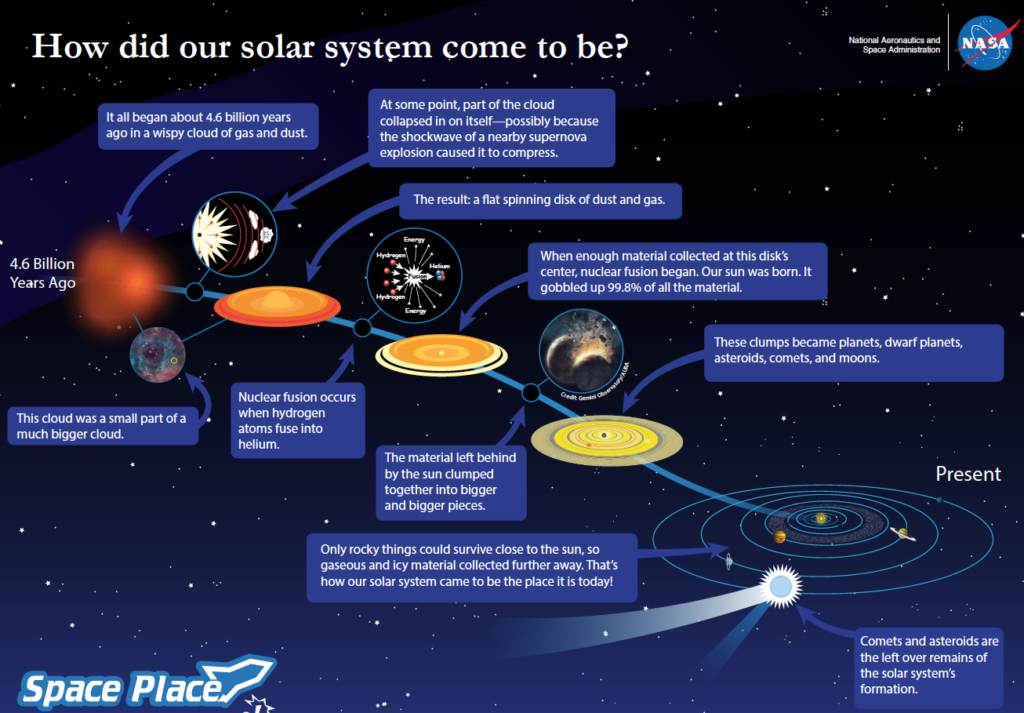
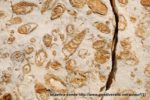
By about 3.5 billion years ago, slightly over a billion years after the Earth’s formation, life was firmly established on Earth. How do we know? There’s fossil evidence. A fossil is “a remnant, impression, or trace of an organism of past geologic ages that has been preserved in the earth’s crust.” (Merriam-Webster). Click on the image to the right to see some fossils of organisms from the time of the dinosaurs.
The fossil remains of the first living organisms are microfossils: they’re the remains of microscopic, single-celled organisms that can only be seen using a microscope and can only be seen well with an electron microscope. These microfossils were found in sandstone that had been part of a marine shoreline over 3.4 billion years ago. This sandstone, which is a type of sedimentary rock, formed as sediments were deposited on the shallow floor of an ancient sea, trapping the bodies of dead single-celled, prokaryotic organisms within the sediments, which became cemented together.
That leads to two questions. 1) How can you know how old a fossil is? 2) What are these ancient, 3.4 bya fossils like? How can we be sure that they’re truly fossils? (Note: “bya” means billion of years ago: I’ll be using that abbreviation from this point forward).
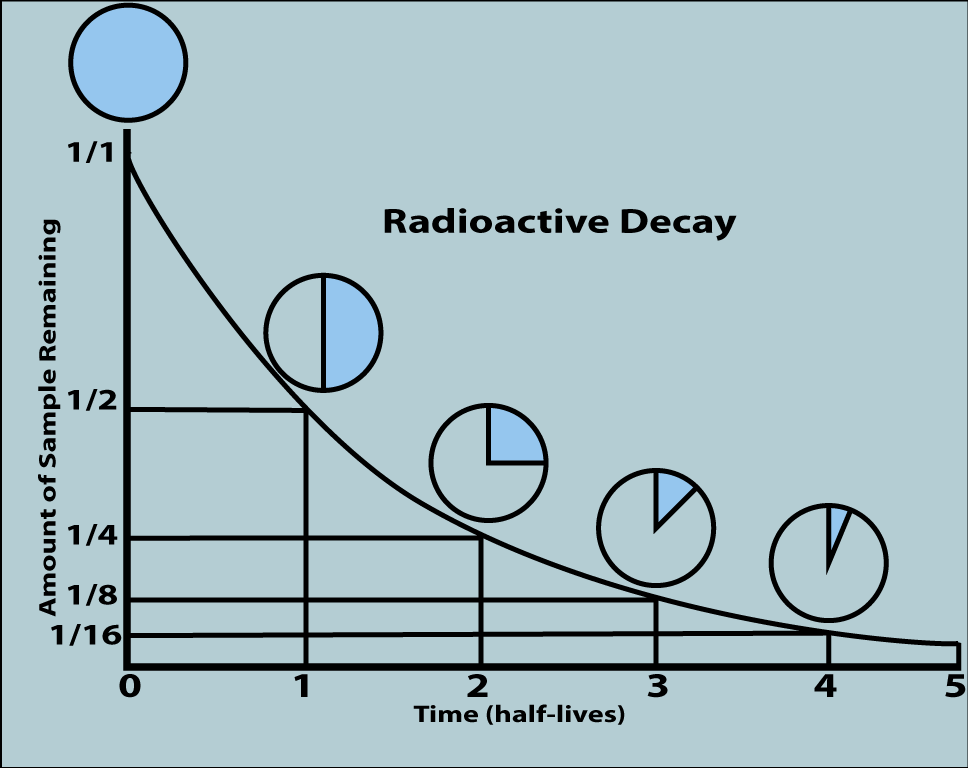
Knowing how old a fossil is involves radiometric dating, which can only be done with volcanic rock. The term “radiometric” combines the words “radiation” with “meter,” and it’s a method of dating specimens by measuring the rate of disintegration of radioactive elements. Here’s how it works.
When a volcanic rock cools, the atoms within it are locked in place: it’s a closed system. Some of the elements of the atoms within that rock will have radioactive isotopes. These are atoms of an element that have an unstable nucleus. That means that the nucleus will emit subatomic particles. Loss of some of these particles will change that atom’s number of protons, changing that atom into a different isotope of a different element.
The loss of mass from radioactivity is called radioactive decay, and it occurs at a predictable rate. That rate is known as the half-life, and it’s the time it takes for half of a sample of a radioactive isotope of an element to transform itself into some other form.
Here’s a contrived example, with very easy math. Isotope X, with a half-life of 100,000 years, decays to isotope Y. If you’re examining a rock and find that the ratio of X to Y is 50/50, then you know that this rock was formed 100,000 years ago (one half-life ago). If the ratio of X to Y was 25/75, then you’d know that two half-lives had passed, and that the rock had formed 200,000 years ago.
If you want to know the age of a very old rock sample, you need to track radioactive decay in an element with a very long half-life. For example, it takes uranium 238 (U238) 4.5 billion years to decay into lead 206 (Pb206). That means that if the ratio of U238 to Pb206 in a sample of rock is 50/50, then that rock sample would be 4.5 billion years old. An online calculator (or use of a formula) would tell you that if the ratio were 58% U238 to 42% Pb206, then this rock would be 3.5 billion years old.
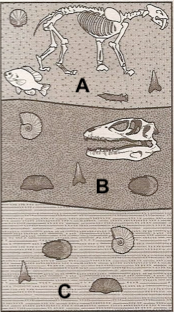
To date a fossil, radioactive dating has to be combined with another geological phenomenon called superposition. Because of the way sediments are laid down, sedimentary rock layers that are closer to the surface are assumed to be younger, while those lower down are assumed to be older. For example, if you were digging through sedimentary layers and found a sequence of fossils like the one shown on the left, you could assume that A is the youngest and C is the oldest.
Now, assume that between layers A and B on the left, there was a layer of volcanic rock. If that rock were 10,000,000 years old, then you’d know that the fossils in layer B were older than 10,000,000 years old and that the fossils in layer A were younger.
So, now we can address the microfossils of early life. A team of scientists (Wacey et al.) from Australia and Great Britain collected sandstone from the 3.4 billion-year-old Strelley Pool Formation in Western Australia. After collection, they cut the sandstone into microscopically thin sections. When viewed under an electron microscope, they saw structures that exhibited “indicators of biological affinity,” including hollow cell walls and cells arranged in chains. Take a moment to study the images below.
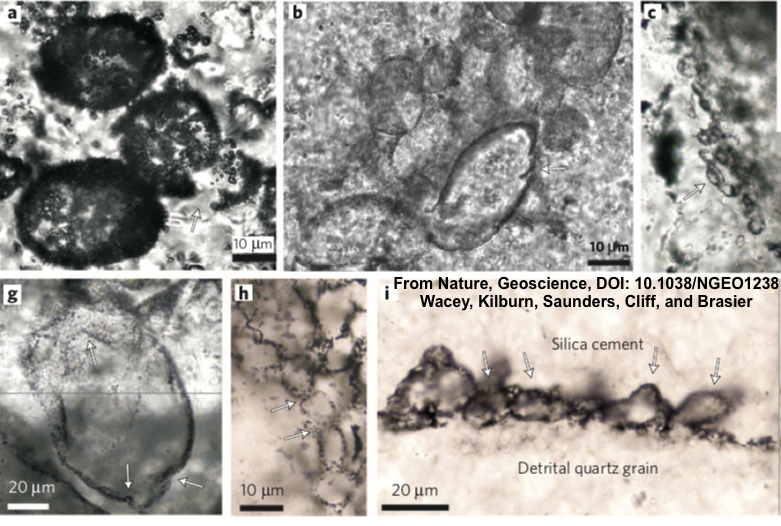
These scientists also chemically analyzed these fossils, finding two more pieces of evidence for their biological origin. The first is the ratio of two carbon isotopes, carbon-12 to carbon-13. This ratio isn’t about radioactive decay. It’s about the fact that living things universally prefer to use the lighter isotope of carbon in their chemical reactions. Wacey et.al found that the samples had 33% to 46% less carbon-13 than would be expected in carbon of non-biological origin, indicating that biological activity had occurred in the creation of these structures. They found similar anomalies in sulfur isotope ratios, leading them to conclude that these were sulfur-metabolizing bacteria. (To read the original study, search for “Microfossils of Sulphur-Metabolizing Cells… Wacey” in Google Scholar).
Another piece of evidence for life at 3.4 bya comes not just from the prokaryotic cells which lived at that time, but from the structures they created. Some bacteria (even today) create layered, mineralized rock formations called stromatolites. Stromatolites form as photosynthesizing bacteria that live in shallow marine waters become covered in sand and other debris. As they reproduce, the new bacteria migrate up to the top of the rock, forming a layer of trapped sediment and bacterial cells. Year after year, the bacteria keep migrating upward, growing on top of their now-deceased ancestors.

If you visit Shark Bay, on the west coast of Australia, you can see living stromatolites (shown below). In terms of evidence for early life, fossilized rock formations with layers thought to be from stromatolites have been found in sedimentary layers that have been dated at 3.4 years old, and, in a disputed finding, even 3.7 billion years old.
Rocks older than about 3.5 bya are generally too deformed by pressure to preserve microfossils. But teams that are studying ratios of carbon 12 to carbon 13 in zircons, graphite-containing crystals, keep pushing the putative date for the origin of life further and further back. Dates as early as 4.1 bya have been reported…and disputed. If you’re interested in some of these more tentative findings, you can read this article from Science magazine, or this article in Wikipedia
What’s the takeaway? Life has been around for a long time. With significant fossil evidence at 3.4 bya, then it’s clear that life existed well before 3.4 bya. But no one knows exactly how long before. And remember that we’re talking about billions of years, so the difference between 3.4 and 3.5 is 100 million years, an immense span of time. In the next tutorial in this module, we’ll start talking about what Earth was like when life arose, and how life could have arisen. But first, take this quiz.
4. When Life Began, Checking Understanding
[qwiz random=”true” qrecord_id=”sciencemusicvideosMeister1961-When Life Began”] [h]
Origin of Life, Quiz 1
[i]
Origin of Life Haiku 2
A stromatolite
Layers of bacteria
Have turned into stone
[q] The Earth is about ______ billion years old.
[hangman]
[c]IDQuNQ==[Qq]
[f]IEdvb2Qh[Qq]
[q] Life first emerged somewhere between 4.1 and 3.5 _________ years ago.
[hangman]
[c]IGJpbGxpb24=[Qq]
[f]IENvcnJlY3Qh[Qq]
[q] Fossilized cells like the ones below are found in remnants of layered bacterial mats called _______.
[hangman]
[c]IHN0cm9tYXRvbGl0ZXM=[Qq]
[f]IEdyZWF0IQ==[Qq]
[q] A key question related to the origin of life is this: if all cells come from other cells, how did the _______ cells arise?
[hangman]
[c]IGZpcnN0[Qq]
[f]IEdyZWF0IQ==[Qq]
[q] According to NASA, life is a self-______________ chemical system capable of Darwinian evolution.
[hangman]
[c]IHN1c3RhaW5pbmc=[Qq]
[f]IEdyZWF0IQ==[Qq]
[q] The four-letter acronym for the organism at the base of the tree of life is
[hangman]
[c]IExVQ0E=[Qq]
[f]IEdyZWF0IQ==[Qq]
[q] Explaining the origin of life involves explaining how the first living chemical systems became enclosed in a ______________.
[hangman]
[c]IG1lbWJyYW5l[Qq]
[f]IEdyZWF0IQ==[Qq]
[q] Fossilized cells like the ones below are evident in rocks that are ______ billion years old
[hangman]
[c]IDMuNA==[Qq]
[f]IEdyZWF0IQ==[Qq]
[q]The best description of the microfossils shown below would be
[c]ZXVrYXJ5b3RpYw==[Qq]
[c]cHJva2Fy eW90aWM=[Qq]
[c]bXVsdGljZWxsdWxhcg==[Qq]
[f]Tm8uIFRoZXNlIGZpcnN0IG9yZ2FuaXNtcyB3ZXJlIGFsbW9zdCBjZXJ0YWlubHkgcHJva2FyeW90aWMu[Qq]
[f]RXhjZWxsZW50LiBUaGVzZSBtaWNyb2Zvc3NpbHMgYXJlIHRob3VnaHQgdG8gYmUgc2ltaWxhciB0byBtb2Rlcm4gcGhvdG9zeW50aGV0aWMgYmx1ZS1ncmVlbiBiYWN0ZXJpYSwgYWxzbyBrbm93biBhcyBjeWFub2JhY3RlcmlhLg==[Qq]
[f]Tm8uIFRoaXMgaXMgYSBmaWxhbWVudCBvciBjaGFpbiBvZiBjZWxscywgYnV0IGl0IGRvZXNuJiM4MjE3O3QgcXVhbGlmeSBhcyBhIG11bHRpY2VsbHVsYXIgb3JnYW5pc20u[Qq]
[q]Features like DNA and ribosomes were almost certainly features of LUCA. Since all living things in every domain of life possess the ATP synthase enzyme/channel, this membrane-based form of creating ATP through [hangman] was likely a feature of LUCA as well.
[c]Y2hlbWlvc21vc2lz[Qq]
[q]Because the enzymes and pathways for glycolysis and fermentation differ between bacteria and archaea, it’s reasonable to conclude that these processes were not present in [hangman], but only evolved later.
[c]TFVDQQ==[Qq]
[q]While the membranes of eukaryotes and bacteria are primarily composed of phospholipids, the third domain of life, the [hangman], use a different type of lipid to construct their membranes.
[c]YXJjaGFlYQ==[Qq]
[q]The precise age of ancient igneous (volcanic) rock can be determined through [hangman] dating.
[c]cmFkaW9tZXRyaWM=[Qq]
[q]Radiometric dating is based on the predictable rate of decay of radioactive [hangman].
[c]aXNvdG9wZXM=[Qq]
[q]Isotope M has a half-life of 500 years, during which it decays into isotope N. You’re studying a sample of material that has a relative proportion of 25% M and 75% N. How old is this material?
[c]IDUwMCB5ZWFycyBvbGQu[Qq]
[f]IE5vLiA1MDAgeWVhcnMgaXMgb25lIGhhbGYtbGlmZSwgZHVyaW5nIHdoaWNoIHRpbWUgeW91JiM4MjE3O2QgZXhwZWN0IGhhbGYgb2YgTSB0byBkZWNheSBpbnRvIE4sIGZvciBhIDUwLzUwIHJhdGlvLg==[Qq]
[c]IDc1IHllYXJzLg==[Qq]
[f]IE5vLiBIZXJlJiM4MjE3O3MgaG93IHRvIHRoaW5rIGFib3V0IHRoaXMuIDUwMCB5ZWFycyBpcyBvbmUgaGFsZi1saWZlLCBkdXJpbmcgd2hpY2ggdGltZSB5b3UmIzgyMTc7ZCBleHBlY3QgaGFsZiBvZiBNIHRvIGRlY2F5IGludG8gTiwgZm9yIGEgNTAvNTAgcmF0aW8uIEJhc2VkIG9uIHRoZSBxdWVzdGlvbiwgZmluZCB0aGUgbnVtYmVyIG9mIGhhbGYtbGl2ZXMsIGFuZCBtdWx0aXBseSB0aGF0IGJ5IHRoZSBkdXJhdGlvbiBvZiBhIGhhbGYtbGlmZS4=[Qq]
[c]IDEwMDAgeW VhcnMgb2xk[Qq]
[f]IEV4Y2VsbGVudC4gSWYgb25seSAyNSUgb2YgdGhlIG9yaWdpbmFsIG1hdGVyaWFsIGlzIGxlZnQsIHRoZW4gdHdvIGhhbGYtbGl2ZXMgaGF2ZSBwYXNzZWQsIGZvciBhIHRvdGFsIG9mIDEwMDAgeWVhcnMu[Qq]
[x][restart]
[/qwiz]
Links
- Early Earth, Key Steps in the Emergence of Life, Stanley Miller, and the Primordial Soup (the next tutorial in this module)
- Origin of Life Menu


